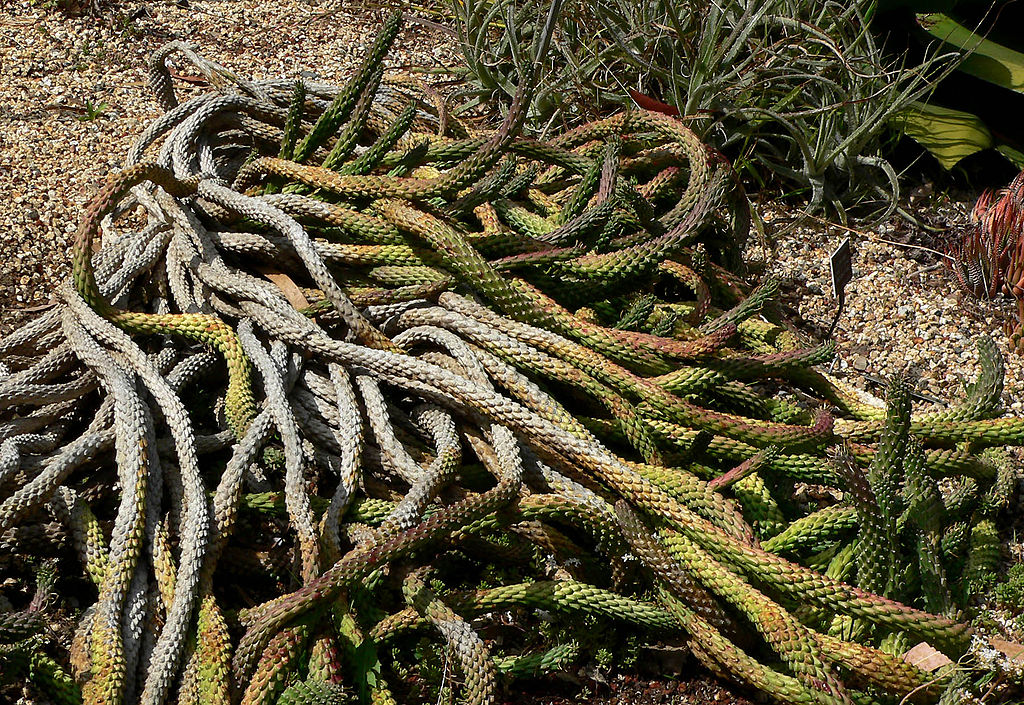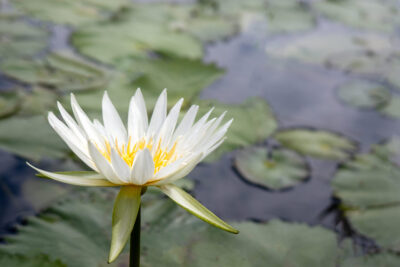
Discover the Fascinating Foliage Patterns of the Snake-Like Succulent!

The world of plants is filled with an incredible array of shapes, colors, and patterns. Among these, the snake-like succulent stands out with its unique and captivating foliage. This fascinating plant, also known as Sansevieria cylindrica, is renowned for its cylindrical leaves that resemble the slithering body of a snake. Its striking appearance and low maintenance requirements have made it a popular choice for indoor and outdoor gardens alike.
We will delve into the mesmerizing world of the snake-like succulent. We will explore the origins and characteristics of this plant, including its natural habitat and growth habits. Additionally, we will discuss the different varieties and cultivars of Sansevieria cylindrica, highlighting their distinct features and patterns. Furthermore, we will provide valuable tips on how to care for and propagate this plant, ensuring its long-lasting beauty in your home or garden. So, join us on this journey as we unravel the secrets of the snake-like succulent and discover why it is a must-have for any plant enthusiast.
- Learn about different types of snake-like succulents and their unique foliage patterns
- Explore various care tips and tricks to keep your snake-like succulent thriving
- Get creative with different arrangements and displays to showcase your snake-like succulent's foliage
- Discover the best lighting conditions for your snake-like succulent to enhance its foliage patterns
- Find out how to propagate snake-like succulents and expand your collection
- Uncover the secrets to preventing common pests and diseases that can damage your snake-like succulent's foliage
- Stay informed about the latest trends and varieties of snake-like succulents with stunning foliage patterns
- Join a community of succulent enthusiasts to share your love for snake-like succulents and exchange tips and advice
- Take stunning photos of your snake-like succulent's foliage and share them on social media to inspire others
- Enjoy the calming and therapeutic benefits of caring for and admiring your snake-like succulent's beautiful foliage
- Frequently Asked Questions
Learn about different types of snake-like succulents and their unique foliage patterns
Snake-like succulents are a mesmerizing addition to any plant collection. With their twisting stems and striking foliage patterns, they add a touch of intrigue and uniqueness to indoor and outdoor spaces. In this article, we will explore some popular types of snake-like succulents and delve into the fascinating world of their foliage patterns.
1. Sansevieria Trifasciata (Snake Plant)
The Snake Plant, also known as Sansevieria Trifasciata, is a classic choice for beginners and experienced succulent enthusiasts alike. Its long, upright leaves feature bold green coloration with variegated patterns that resemble snakeskin. These patterns can vary from vertical stripes to mottled patches, adding depth and texture to the plant.
2. Haworthia Fasciata (Zebra Plant)
The Zebra Plant, scientifically known as Haworthia Fasciata, is another snake-like succulent with eye-catching foliage. Its leaves are short and triangular, arranged in a rosette pattern. The unique feature of this succulent is the white, horizontal stripes that resemble the stripes on a zebra. This distinct pattern creates a visual interest and makes it a popular choice for succulent enthusiasts.
3. Dracaena Trifasciata (Golden Hahnii)
The Golden Hahnii, scientifically referred to as Dracaena Trifasciata, is a compact snake-like succulent with a stunning foliage pattern. Its leaves are short and wide, growing in a rosette formation. The foliage showcases a gorgeous golden-yellow coloration with dark green, snake-like patterns. This combination of colors adds a touch of elegance and brightness to any space.
 Comparing Sizes: A Guide to the Different Sizes of Succulents
Comparing Sizes: A Guide to the Different Sizes of SucculentsThese are just a few examples of the diverse range of snake-like succulents and their unique foliage patterns. Whether you prefer the bold stripes of the Snake Plant, the zebra-like stripes of the Zebra Plant, or the golden-yellow patterns of the Golden Hahnii, there is a snake-like succulent to suit every taste and style.
When caring for snake-like succulents, it's important to provide them with well-draining soil, moderate sunlight, and infrequent watering. They are generally low-maintenance plants that thrive in a variety of environments. With proper care, these fascinating succulents will continue to mesmerize you with their captivating foliage patterns for years to come.
Explore various care tips and tricks to keep your snake-like succulent thriving
If you are a plant enthusiast looking to add a unique touch to your collection, look no further than the snake-like succulent. With its mesmerizing foliage patterns, this succulent is sure to grab attention and become a conversation starter.
1. Choose the right spot: Snake-like succulents thrive in bright, indirect light. Place them near a window where they can receive ample sunlight without being exposed to direct rays.
2. Mind the temperature: These succulents prefer warmer temperatures ranging from 70 to 80 degrees Fahrenheit (21 to 27 degrees Celsius). Avoid placing them in drafty areas or near air conditioning vents.
3. Water sparingly: Snake-like succulents are adapted to arid conditions and have low water requirements. Allow the soil to dry out completely between waterings and always use well-draining soil to prevent root rot.
 Can Succulents Imitate the Appearance of a Human Brain?
Can Succulents Imitate the Appearance of a Human Brain?4. Don't overfeed: Fertilize your snake-like succulent sparingly. During the growing season, feed it with a balanced, water-soluble succulent fertilizer diluted to half the recommended strength once a month.
5. Handle with care: The leaves of snake-like succulents are delicate and can easily break off. Be gentle while handling them and avoid placing them in high-traffic areas where they might get bumped or knocked over.
6. Propagation: Snake-like succulents can be propagated through leaf cuttings. Simply remove a healthy leaf from the plant, let it dry for a few days to form a callus, and then place it on well-draining soil. Keep the soil slightly moist until new roots and shoots start to form.
7. Watch out for pests: While snake-like succulents are generally resilient, they can still fall victim to common pests like mealybugs or spider mites. Regularly inspect your plants for any signs of infestation and treat them promptly if necessary.
By following these care tips and tricks, you can ensure that your snake-like succulent remains healthy and vibrant, showcasing its stunning foliage patterns for years to come. So go ahead, bring home this captivating succulent and marvel at its beauty!
Get creative with different arrangements and displays to showcase your snake-like succulent's foliage
When it comes to showcasing the unique and captivating foliage patterns of your snake-like succulent, the possibilities are endless. With their intricate, winding leaves resembling the scales of a serpent, these succulents are truly a sight to behold. By experimenting with different arrangements and displays, you can highlight the mesmerizing beauty of your snake-like succulent and create an eye-catching focal point in any space.
1. Vertical Gardens
One creative way to showcase your snake-like succulent is by creating a vertical garden. Use a wall-mounted planter or a series of hanging pots to display your succulent collection. Arrange your snake-like succulents alongside other varieties to create an interesting contrast of textures and colors. This unique display will not only be visually stunning but also save valuable floor space.
 Discover the Stunning Resemblance: A Lettuce-Like Succulent
Discover the Stunning Resemblance: A Lettuce-Like Succulent2. Terrariums
Another popular option is to create a succulent terrarium. These miniature ecosystems provide the perfect environment for your snake-like succulent to thrive. Choose a glass container with a lid to create a humid atmosphere that mimics the succulent's natural habitat. Layer the terrarium with rocks, gravel, and well-draining soil before carefully planting your succulent. The transparent walls of the terrarium will allow you to appreciate the intricate patterns of your snake-like succulent up close.
3. Mixed Planters
If you want to add a touch of diversity to your snake-like succulent display, consider planting it in a mixed planter. Combine different types of succulents in various shapes, sizes, and colors to create a visually appealing arrangement. The snake-like succulent's unique foliage patterns will add an element of intrigue and charm to the overall composition. Ensure the planter has proper drainage to prevent overwatering and maintain the health of your plants.
4. Hanging Baskets
For a whimsical and space-saving display, consider using hanging baskets to showcase your snake-like succulent. Opt for baskets with an open weave design to allow the succulent's trailing leaves to cascade gracefully. Hang these baskets in areas such as porches, balconies, or patios to create a stunning vertical display. Ensure the baskets are securely hung and provide adequate sunlight for your succulent to thrive.
5. Individual Containers
If you prefer a more minimalist approach, highlighting the beauty of your snake-like succulent in individual containers is a great option. Choose stylish pots or planters that complement the unique foliage patterns of your succulent. Place them on windowsills, shelves, or desktops to add a touch of elegance and greenery to your living or working space. Remember to use well-draining soil and water your succulent sparingly to prevent root rot.
Regardless of the display option you choose, the key is to let the striking foliage patterns of your snake-like succulent take center stage. Get creative, experiment with different arrangements, and watch as your succulent becomes the talk of the town!
Discover the best lighting conditions for your snake-like succulent to enhance its foliage patterns
When it comes to snake-like succulents, their fascinating foliage patterns are one of the main reasons why they have become so popular among plant enthusiasts. These unique patterns resemble the scales of a snake, making them a captivating addition to any indoor or outdoor space.
 Exploring the Existence of Naturally Blue Succulents: Fact or Fiction?
Exploring the Existence of Naturally Blue Succulents: Fact or Fiction?However, to truly appreciate and enhance the beauty of these foliage patterns, it is crucial to provide the right lighting conditions for your snake-like succulent. Here are some tips to help you create the perfect environment for your plant:
1. Bright Indirect Light
Snake-like succulents thrive in bright indirect light. Placing them near a window that receives filtered sunlight is ideal. Direct sunlight can scorch the leaves, resulting in dull foliage patterns. It is important to strike a balance between providing enough light for the plant to grow and avoiding direct exposure to harsh sunlight.
2. Avoid Low Light Areas
While snake-like succulents can tolerate lower light conditions, they will not display their foliage patterns as vibrantly as they would in brighter light. Avoid placing them in areas that receive minimal natural light or are shaded for most of the day. This can cause the patterns to fade and the plant to stretch towards the light source, resulting in a less compact and visually appealing appearance.
3. Rotate the Plant Regularly
To ensure even growth and development of foliage patterns, it is recommended to rotate your snake-like succulent every few weeks. This will prevent the plant from leaning or growing towards one direction, allowing all sides to receive equal exposure to light. Rotating the plant also encourages symmetrical growth, enhancing the overall aesthetic appeal.
4. Supplement with Artificial Light
If you are unable to provide sufficient natural light, you can supplement your snake-like succulent with artificial light. LED grow lights or fluorescent lights are excellent options for providing the necessary light intensity and spectrum. Position the lights about 12-18 inches away from the plant and adjust the duration based on the specific requirements of your succulent species.
By following these lighting tips, you can ensure that your snake-like succulent displays its foliage patterns to their full potential. Remember, the right lighting conditions are crucial for the overall health and visual appeal of your plant. So, go ahead and create the perfect environment for your snake-like succulent to thrive!
Find out how to propagate snake-like succulents and expand your collection
 Air Plants vs Succulents: Differences and Similarities
Air Plants vs Succulents: Differences and SimilaritiesIf you're a succulent enthusiast looking to add some unique plants to your collection, snake-like succulents are a must-have! These fascinating plants, also known as Sansevieria or snake plants, are known for their striking foliage patterns that resemble the skin of a snake.
One of the best things about snake-like succulents is that they are relatively easy to propagate, making it simple to expand your collection. Whether you're a seasoned succulent grower or a beginner, propagating snake-like succulents can be a rewarding experience.
Propagation Methods
There are several methods you can use to propagate snake-like succulents:
- Leaf Cuttings: Select a healthy leaf from the mother plant and cut it at an angle. Let the cut end dry for a few days until it forms a callus. Place the callused end in well-draining soil, and within a few weeks, roots will develop, and a new plantlet will grow.
- Division: If your snake-like succulent has multiple shoots or offsets, you can carefully separate them from the mother plant by gently pulling them apart. Plant the offsets in their individual pots and provide them with the same care as the parent plant.
- Rhizome Division: For snake-like succulents with rhizomes, such as Sansevieria cylindrica, division is an effective propagation method. Gently remove the plant from its pot, and using a clean, sharp knife, divide the rhizomes into smaller sections. Ensure each section has some healthy roots and leaves before planting them.
Propagation Tips
Here are some tips to keep in mind when propagating snake-like succulents:
- Choose Healthy Leaves: Select leaves that are firm, free from pests or diseases, and have a good amount of green color.
- Use Well-Draining Soil: Snake-like succulents prefer well-draining soil to prevent root rot. You can mix cactus soil with perlite or pumice to improve drainage.
- Provide Adequate Light: Snake-like succulents thrive in bright, indirect light. Place them near a window or provide them with artificial grow lights.
- Water Sparingly: Overwatering can lead to root rot in snake-like succulents. Allow the soil to dry out between waterings and water only when the top inch of soil is dry.
- Be Patient: Snake-like succulents may take some time to establish roots and grow new plantlets. Patience is key during the propagation process.
By following these propagation methods and tips, you can successfully propagate snake-like succulents and add more of these stunning plants to your collection. Enjoy the process of watching new plants grow and create a mesmerizing display of foliage patterns in your home or garden!
Uncover the secrets to preventing common pests and diseases that can damage your snake-like succulent's foliage
As a proud owner of a snake-like succulent, you may have noticed the mesmerizing patterns and unique foliage that make these plants truly captivating. However, just like any other plant, snake-like succulents are not immune to pests and diseases that can harm their foliage. In this article, we will delve into the fascinating foliage patterns of these succulents and explore effective ways to prevent and combat common pests and diseases.
 Identifying and Recognizing Common Succulent Plants Guide
Identifying and Recognizing Common Succulent Plants GuideUnderstanding the Fascinating Foliage Patterns
Snake-like succulents, also known as snake plants or Sansevieria, are renowned for their striking foliage patterns. Their leaves feature intricate combinations of colors, ranging from vibrant greens to deep shades of variegation. Some snake-like succulents exhibit zebra-like patterns, while others showcase waves and stripes, resembling the slithering motion of a snake.
These fascinating foliage patterns are not only visually appealing but also serve a purpose. The unique patterns help the snake-like succulents adapt to their native habitats by providing camouflage or reflecting sunlight to minimize water loss. By understanding and appreciating these patterns, you can enhance your admiration for these remarkable plants.
Preventing Pests and Diseases
While snake-like succulents are generally resilient, they can still fall victim to pests and diseases. The most common pests that can infest these plants include mealybugs, spider mites, and scale insects. These tiny intruders can weaken the succulent's foliage and hinder its growth if left untreated.
To prevent pests from wreaking havoc on your snake-like succulent, it is crucial to maintain a clean and healthy environment. Regularly inspect your plant for any signs of infestation, such as webs, discolored leaves, or sticky residue. If you spot any pests, isolate the affected plant immediately and treat it with an appropriate organic pesticide or insecticidal soap.
In addition to pests, snake-like succulents can also be susceptible to fungal and bacterial diseases. Overwatering, poor drainage, and high humidity levels can create a favorable environment for these diseases to thrive. To prevent such issues, ensure that you water your succulent sparingly and allow the soil to dry between waterings. Furthermore, provide adequate ventilation and avoid overcrowding your plants to reduce humidity levels.
Combatting Pests and Diseases
If your snake-like succulent does fall victim to pests or diseases, don't fret! There are effective ways to combat these issues and restore your plant's health. For pests, you can manually remove them using a cotton swab dipped in rubbing alcohol or a gentle spray of water. Alternatively, beneficial insects like ladybugs or predatory mites can be introduced to your indoor garden to naturally control pest populations.
When it comes to fungal and bacterial diseases, prevention is key. However, if your succulent does become infected, it is essential to act promptly. Remove the affected foliage and treat the plant with a fungicide or bactericide specifically formulated for succulents. Remember to follow the instructions on the product label carefully and repeat the treatment as necessary.
 Are Mermaid Tail Succulents Real? A Care Guide for Enchanting Plants
Are Mermaid Tail Succulents Real? A Care Guide for Enchanting PlantsBy understanding the fascinating foliage patterns of snake-like succulents and implementing preventive measures against pests and diseases, you can ensure that your plants thrive and continue to mesmerize with their captivating beauty. So, unleash your inner horticulturist and embark on a journey to discover the wonders of these snake-like succulents!
Stay informed about the latest trends and varieties of snake-like succulents with stunning foliage patterns
If you're a plant enthusiast or simply looking to add some greenery to your home, snake-like succulents are a must-have. These unique plants have gained popularity in recent years due to their striking foliage patterns that resemble the scales of a snake.
Snake-like succulents, also known as snake plants or Sansevieria, are characterized by their long, slender leaves that grow upright, resembling the shape of a snake. What sets them apart is the mesmerizing patterns and colors that adorn their leaves, making them a captivating addition to any indoor or outdoor space.
Why snake-like succulents are so fascinating
One of the main reasons snake-like succulents are so fascinating is their incredible ability to adapt and survive in various conditions. These plants are highly resilient and can thrive in both low-light and bright areas, making them ideal for all types of environments.
Another reason these succulents are highly sought after is their air-purifying properties. Snake plants are known to improve indoor air quality by filtering out toxins such as formaldehyde, benzene, and trichloroethylene.
Furthermore, snake-like succulents are relatively low-maintenance, making them perfect for busy individuals or those new to plant care. They can tolerate periods of neglect and require minimal watering, making them an excellent choice for those with a busy schedule.
 Expert Help Identifying Various Succulent Houseplants
Expert Help Identifying Various Succulent HouseplantsDiscovering the mesmerizing foliage patterns
One of the most intriguing aspects of snake-like succulents is the wide range of foliage patterns they exhibit. From bold, dark green leaves with yellow edges to lighter, variegated patterns, these plants offer a stunning visual display.
Some popular varieties include:
- Sansevieria trifasciata 'Black Coral' - This variety features dark green leaves with striking horizontal bands of light green, giving it a unique and eye-catching appearance.
- Sansevieria trifasciata 'Golden Hahnii' - As the name suggests, this snake-like succulent boasts rich golden-yellow edges that beautifully contrast with its deep green foliage.
- Sansevieria cylindrica 'Boncel' - This variety is known for its cylindrical leaves that grow in a compact rosette formation, featuring eye-catching horizontal bands of light and dark green.
These are just a few examples of the incredible variety found within the snake-like succulent family. With their unique foliage patterns, they add a touch of elegance and natural beauty to any space.
If you're looking to add a touch of exotic beauty to your home or office, snake-like succulents with their fascinating foliage patterns are the perfect choice. Not only are they visually captivating, but they also offer numerous benefits, including air purification and low maintenance. Keep up with the latest trends and discover the mesmerizing world of snake-like succulents!
Are you fascinated by the unique beauty of snake-like succulents? Do you find yourself captivated by their intricate foliage patterns? If so, you're not alone! Join a vibrant community of succulent enthusiasts who share your passion for these mesmerizing plants.
Snake-like succulents, also known as snake plants or Sansevieria, are renowned for their striking foliage that resembles the skin of a snake. These plants come in a variety of cultivars, each with its own distinct pattern, color, and texture. From the classic, deep green leaves with horizontal yellow stripes to the variegated varieties featuring intricate patterns of white and green, there is a snake-like succulent to suit every taste and style.
By joining our community, you'll have the opportunity to connect with fellow snake-like succulent lovers from around the world. Share your experiences, ask questions, and be inspired by the vibrant discussions and stunning photos shared by our members.
 Exploring the Tube-Shaped Leaves of Succulents: A Guide
Exploring the Tube-Shaped Leaves of Succulents: A GuideExchange tips and advice for growing and caring for snake-like succulents
One of the most valuable aspects of our community is the wealth of knowledge and expertise shared by our members. Whether you're a seasoned succulent enthusiast or just starting your journey with snake-like succulents, you'll find a wealth of tips and advice to help you succeed in cultivating these remarkable plants.
Discover the best practices for watering, sunlight exposure, and soil requirements to ensure your snake-like succulents thrive. Learn how to propagate your plants and create new additions to your collection. Our members are always eager to share their experiences and offer guidance to help you overcome any challenges you may encounter on your succulent journey.
Stay up-to-date with the latest trends and developments in the world of snake-like succulents
As a member of our community, you'll gain access to a wealth of information about the latest trends and developments in the world of snake-like succulents. From new cultivars and hybrids to innovative propagation techniques, you'll be at the forefront of all things snake-like succulents.
Be inspired by the stunning photos shared by our members, showcasing the diverse range of snake-like succulents in their collections. Discover new ways to incorporate these plants into your home decor and create eye-catching displays that are sure to impress.
Don't miss out on the opportunity to connect with like-minded individuals who share your love for snake-like succulents. Join our community today and embark on an exciting journey into the fascinating world of snake-like succulents!
If you are a plant lover or an avid photographer, you'll be captivated by the intricate foliage patterns of the snake-like succulent. This unique plant species boasts mesmerizing designs on its leaves, making it a perfect subject for photography enthusiasts.
The snake-like succulent, also known as Sansevieria or Snake Plant, is a popular choice among plant enthusiasts due to its striking appearance and low maintenance requirements. Its elongated leaves display a variety of patterns, ranging from bold stripes to intricate spots, creating a visually appealing display in any indoor or outdoor setting.
 Identifying the Succulent with Jagged-Edged Leaves: A Guide
Identifying the Succulent with Jagged-Edged Leaves: A GuideWhen photographing your snake-like succulent, make sure to pay attention to the lighting and background. Natural light is often the best choice to bring out the vivid colors and details of the foliage. Experiment with different angles and perspectives to capture the unique patterns and textures of the leaves.
Here are some tips to help you take stunning photos of your snake-like succulent:
- Choose the right lighting: Natural, diffused light works best for showcasing the intricate patterns of the foliage. Avoid harsh direct sunlight, as it can wash out the details.
- Play with angles: Get creative with your shots by experimenting with different angles and perspectives. Capture close-ups of the leaves to highlight their unique patterns, or take a step back and capture the entire plant in its natural environment.
- Focus on details: Zoom in on specific sections of the leaves to capture the intricate patterns and textures. Macro lenses or smartphone macro attachments can help you achieve sharp and detailed shots.
- Consider the background: Choose a background that complements the colors and patterns of your snake-like succulent. A plain, contrasting backdrop can help your plant stand out and become the focal point of the photo.
- Experiment with editing: Post-processing can enhance the colors and details of your snake-like succulent photos. Use photo editing software or apps to adjust brightness, contrast, and saturation to achieve the desired effect.
Once you have captured stunning photos of your snake-like succulent, don't hesitate to share them on social media platforms such as Instagram or Facebook. Your captivating images can inspire other plant lovers and photography enthusiasts, and perhaps even spark their curiosity about these fascinating plants.
So, grab your camera or smartphone and start exploring the captivating world of snake-like succulents. Unleash your creativity, capture the intricate patterns, and share the beauty of these plants with the world!
Enjoy the calming and therapeutic benefits of caring for and admiring your snake-like succulent's beautiful foliage
The snake-like succulent is a mesmerizing plant that captivates with its unique foliage patterns. Its leaves, which resemble the scales of a snake, create a visually stunning display that is sure to catch the eye of any plant enthusiast.
Not only is this succulent visually appealing, but it also offers several therapeutic benefits. Caring for and admiring your snake-like succulent can have a calming effect on your mind and body, making it a perfect addition to your indoor or outdoor space.
1. Aesthetically Pleasing Foliage
The foliage of the snake-like succulent is its standout feature. The leaves grow in a spiral pattern, resembling the slithering movement of a snake. They come in various shades of green, ranging from vibrant lime to deep emerald, adding a touch of natural beauty to any setting.
The unique foliage patterns of this succulent make it an excellent addition to your plant collection, whether displayed individually or in a group. Its distinctive appearance is sure to be a conversation starter and a focal point in any room or garden.
2. Low Maintenance
If you're a busy individual or a beginner in gardening, the snake-like succulent is the perfect plant for you. It is known for its low maintenance requirements, making it an excellent choice for those with a hectic lifestyle.
This succulent thrives in well-draining soil and only requires occasional watering. It can tolerate a wide range of light conditions, from bright indirect light to partial shade. With minimal effort, you can enjoy the beauty of its foliage without the stress of constant care.
3. Stress-Relieving Effects
Engaging with nature has been proven to have a positive impact on mental health, and the snake-like succulent is no exception. Caring for plants, such as this succulent, can promote relaxation and reduce stress levels.
Observing the intricate patterns and textures of its foliage can have a calming effect on the mind, allowing you to unwind and find solace in nature. Taking a few moments each day to tend to your snake-like succulent can be a therapeutic practice that brings a sense of peace and tranquility.
4. Versatile Display Options
The snake-like succulent offers endless possibilities when it comes to displaying it in your space. Its unique shape and foliage patterns make it an ideal choice for various settings.
- Place it on a windowsill where it can bask in the soft sunlight, accentuating its intricate leaves.
- Create a captivating centerpiece by arranging multiple snake-like succulents in a decorative pot.
- Add an exotic touch to your garden by incorporating this succulent into your outdoor landscape.
With its versatility, you can let your creativity soar and find the perfect spot to showcase the beauty of your snake-like succulent.
The snake-like succulent is a fascinating plant that offers both visual appeal and therapeutic benefits. Its foliage patterns are aesthetically pleasing, and caring for this low-maintenance plant can help reduce stress levels. Whether you choose to display it indoors or outdoors, the snake-like succulent is sure to bring a touch of natural beauty to any space.
Frequently Asked Questions
1. What is a snake-like succulent?
A snake-like succulent is a type of plant that has long, slender leaves that resemble the shape and pattern of a snake.
2. How do you care for a snake-like succulent?
Snake-like succulents require bright indirect light, well-draining soil, and infrequent watering to thrive. They are low-maintenance plants.
3. Can snake-like succulents be grown indoors?
Yes, snake-like succulents can be grown indoors as long as they receive enough sunlight and are placed near a window or under grow lights.
4. Are snake-like succulents poisonous?
Snake-like succulents are generally non-toxic to humans and pets. However, it's always best to keep them out of reach to prevent any accidental ingestion.
If you want to read more articles similar to Discover the Fascinating Foliage Patterns of the Snake-Like Succulent!, you can visit the Identification category.






You Must Read